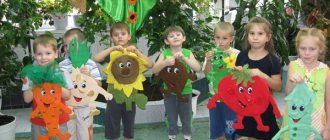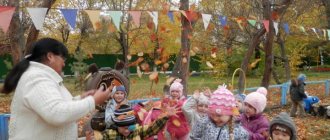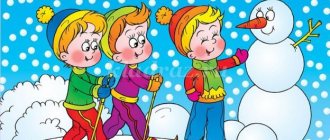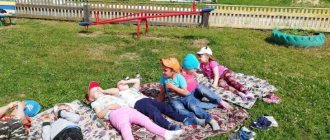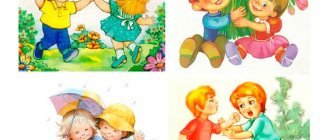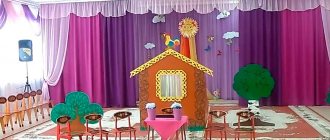Progress of observation:
-What sky?
-What clouds?
-What do they look like?
Draw children's attention to the sky. At the beginning of autumn it is still clear, blue, clouds are floating across the sky. Consider how beautiful they are: white, fluffy, “light, airy, obedient to the breeze”
, look like pieces of cotton wool.
Woven from lace
Birds-clouds.
Maybe it's a fairy tale
Rushing through the centuries?
Folk sign: if the sky is covered with many crowded “small lambs”
- to rain, but if the clouds take on sharp outlines and the distance between them increases, there will be no rain.
Games and game exercises:
“What does a cloud look like?”
Search activity:
Find similarities between clouds and animals. "Metamorphosis"
in animals, imitating their movements.
Labor activity:
Collect leaves, pebbles, sticks in buckets, pour into large buckets.
Goal: to instill basic labor skills.
Outdoor games:
"Tumala - aash"
Purpose: to train children in fast running; develop attention and observation.
"Catch a mosquito"
.
Purpose: to train children in jumping; develop dexterity of movements.
Individual work:
"Roll the ball"
.
Purpose: to train children in rolling the ball to each other; develop the eye.
Card No. 3
Watching the wind
Goal: to form first ideas about some phenomena of inanimate nature.
Observations of nature in spring
Svetlana Stanislavovna Maltseva, teacher of the first qualification category, SP GBOU secondary school No. 4 - “Kindergarten” Samara region, Syzran city
Spring _
Getting to know nature in everyday life
Observation and work on site. In spring, as in other seasons, they observe changes in inanimate nature. Children develop knowledge about the gradual increase in spring phenomena, about the change in spring phenomena. Observations of the increase in the length of the day are conducted and recorded (5-6 observations per season), it is noted that the day is becoming longer.
A characteristic phenomenon for the beginning of spring is the appearance of icicles. Several observations are devoted to this. Children watch the growth of icicles. Preschoolers are led to understand the reasons for the growth of icicles. To do this, they suggest listening to the drops, and note that in frosty and cloudy weather there are no drops. They ask whether there are drops in the morning and evening, and establish a relationship between the melting of icicles and the air temperature. When the icicles melt, they find out why they are gone.
With the onset of warm days, the snow melts and streams flow. You can measure the height of the remaining snow cover, consider what the snow has become (in color and quality). On one of the walks, the children find the first thawed patches and find out why the snow does not disappear everywhere at the same time.
It is interesting to watch the first rain with children, to note the characteristic features of this phenomenon in the spring (heavy; short or shallow, long). You can watch the first thunderstorm, listen to the thunder roar.
As the weather gets warmer, the teacher brings toys to the area to play with water, plays the game “Drowns and floats”, together with the children creates dams, launches boats, etc.
Observation of plants.
The first spring awakening of plants is best shown on willow. The snow has just begun to melt, and silvery fluffy buds have already appeared on the willow. Children examine them and stroke them carefully. The teacher draws the children's attention to the fact that the kidneys are covered with silvery down - this is how they are protected from the cold. You can cut a few branches, place this spring bouquet in a group and watch how the fluffy buds grow. At the beginning of spring, it is interesting to see the flowering of alder, aspen, and hazel.
The emergence of grass is also being monitored. It is established that the first shoots of greenery appear in places heated by the sun. The children come to the conclusion: the sun warmed up, the snow melted, the soil warmed up, and the grass began to grow. It is also necessary to observe the appearance of primroses: take a walk to the place where the coltsfoot blooms, determine where its first bushes appeared: (in a well-lit and sun-warmed place), examine the flowers. During a walk, you can find anemone, coppice, dig it up (one plant at a time) and place it in a group for further observation.
In the spring, it is interesting to observe the swelling of buds on trees and shrubs, to remember what buds were on the poplar and lilac in winter, how they have changed now. Repeated observation is carried out after the buds open and the leaves appear.
Several observations of the flowering of trees (bird cherry, rowan) and shrubs (lilac) are carried out. The teacher asks if the children remember how bird cherry, rowan, and lilac bloom, and tries to make them expect the flowers to appear. The observation is repeated at the moment the first flowers appear and then during the full flowering of these trees and shrubs.
Of particular interest to children is long-term observation of the development of dandelion. While there are no flowers, you need to look at the leaves, show how interesting they grow - as if straight from the ground, then on a long stem there is a bud that looks like a round box, show how the bud opens and a flower appears. They find flowers that are partially and fully opened, examine the yellow petals and the long stem.
It is good to carry out repeated observations during the flowering period of dandelions. On a sunny day, children will see a “golden meadow”; If you come to this place in the evening or on a cloudy day, you can observe something else - the dandelions have not opened. You should associate the opening of a dandelion flower with the degree of illumination, read M. Prishvin’s story “The Golden Meadow”.
Final observations are carried out when white fluffy balls appear on the dandelions, and seeds with fluffy parachutes ripen. As soon as you blow on the ball, the seeds - parachutes - are carried in different directions. Dandelions can be found with buds, flowers, and seeds. Knowledge about the dandelion development cycle is consolidated - the appearance of leaves in spring, the appearance of a bud, flowering, ripening of seeds and their dispersal (this is already at the beginning of summer).
In the spring, systematic observations are made of the growth and development of plants in the flower garden and vegetable garden: iris leaves have appeared, the leaves of viola, daisies, and forget-me-nots are turning green, and the reddish leaves of peonies are growing.
At the site, children clear the flower beds from last year’s remaining grass and dried stems, carefully dig up the plants, and loosen the soil. They are also involved in feeding plants, and the importance of these methods of care is explained. During spring and summer, the teacher organizes care for the plants of the flower garden and vegetable garden, teaches children how to care, and develops the ability to determine the need for one or another method (watering, loosening, weeding). During the care process, long-term observations of some plants in the flower garden and vegetable garden are carried out.
Animal observations. At the beginning of spring, children's attention is drawn to the lively behavior of wintering birds: sparrows chirp cheerfully, swim in puddles; In parks and squares the first ringing song of the great tit is heard. We need to teach children to recognize the song of a tit.
The most vivid impression of spring is the arrival of rooks. Even before their arrival, you need to show the children an empty rookery, pay attention to how quiet and empty it is, ask if they remember what the rookery was like last year, what the rooks did then. Children wait with interest for the arrival of birds. Repeated observation in the rookery should be carried out after the arrival of the rooks. The teacher suggests listening to the cry of birds and trying to distinguish the cry of a rook from a crow. Subsequent observations are carried out during the period of nest construction to find out what the rooks carry into the nests and for whom they are building them. Once again you can come to the rookery when the birds are hatching their chicks and observe the behavior of the rooks during this period.
At the beginning of spring, a birdhouse is hung on the site. They mark the day the starlings arrive, observe their behavior at the birdhouse: they sit on a perch, sing, and rest. In the following days, the children watch how the starlings fly into the birdhouse, what they do there, how quickly they run across the snow-free lawns, what they do.
Finches are among the first birds to arrive. Let the children listen to him: they will remember his song. The finch is easy to see on tree branches as long as there are no leaves.
Simultaneously with observing the arrival of birds, it is necessary to monitor the appearance of insects. The first butterflies - lemongrass, urticaria - can be observed not yet flying, but sitting in the sun on the fence or walls of the house. Seeing such a butterfly, the teacher invites the children to carefully touch it with a straw (it crawls, but does not fly), explains that the butterfly has just crawled out of the shelter where it slept all winter and is basking in the sun; she can't fly yet. The sun will warm up more, it will become warmer, and the butterfly will fly. Children learn to distinguish between lemongrass and urticaria butterflies (or other species).
In the second half of spring, it is noted that there are more butterflies, bumblebees, bees, ladybugs, and chafers have appeared. While observing them, pay attention to where they can be seen (on flowers, on tree leaves, in the grass), what they do; exercise children in distinguishing 2-3 types of butterflies, beetles (chafer beetle, ground beetle, etc.), having caught 1-2 butterflies, place them in a cage in a corner
Author: Svetlana Stanislavovna Maltseva Position: teacher of the first qualification category Place of work: SP GBOU secondary school No. 4 - “Kindergarten” Location: Samara region, Syzran City notes Lesson notes Observations of nature in spring PowerPoint presentation templates Observations of nature in spring
Date modified: April 25, 2015 Date published: April 25, 2015
